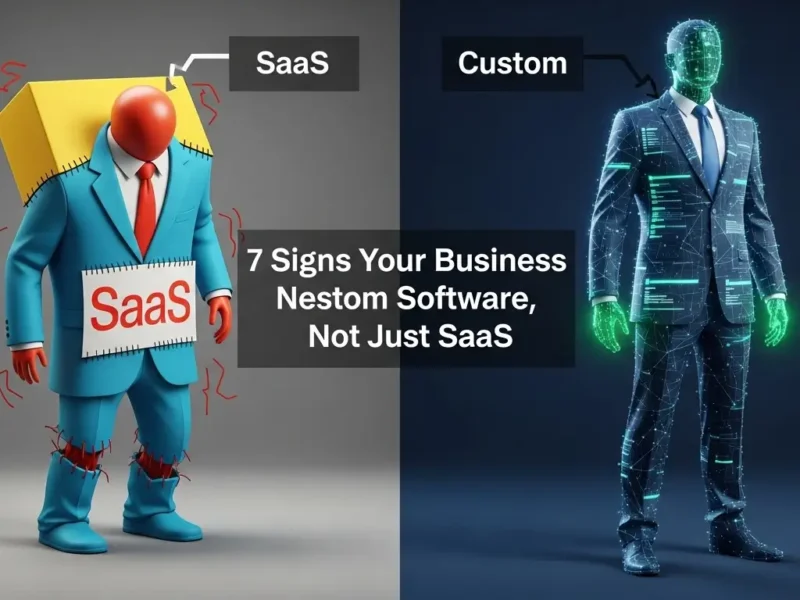In today’s rapidly evolving digital landscape, off-the-shelf software often falls short of meeting unique business demands. This is where custom software development steps in, offering tailored solutions that drive efficiency, innovation, and competitive advantage. But embarking on a custom software journey can seem daunting without a clear roadmap. That roadmap is the Custom Software Development Lifecycle (CSDLC) – a structured process ensuring your project moves from a nascent idea to a robust, fully functional solution, often guided by an experienced custom software development company.
Understanding the CSDLC is not just for developers; it’s crucial for business leaders, project managers, and anyone investing in a bespoke digital solution. It demystifies the complex process, providing transparency, managing expectations, and ultimately guaranteeing a higher probability of success. This comprehensive, step-by-step guide will walk you through each critical phase, illuminating how a well-executed CSDLC transforms vision into a tangible, high-performing asset.
What is the Custom Software Development Lifecycle (CSDLC)?
The Custom Software Development Lifecycle (CSDLC), often an adaptation of the broader Software Development Life Cycle (SDLC), is a systematic process that guides custom software projects from initial concept to deployment and ongoing maintenance. It comprises a series of well-defined stages, each with specific objectives and deliverables. The primary goal of the CSDLC is to produce high-quality, cost-effective software that meets specific business requirements within a predetermined timeframe.
While various methodologies exist (like Agile, Waterfall, DevOps), the core phases of the CSDLC remain largely consistent. It’s a framework designed to improve project planning, mitigate risks, enhance collaboration, and ensure the final product aligns perfectly with the client’s needs. By adhering to a structured CSDLC, businesses can navigate the complexities of software creation with confidence, ensuring predictability and quality at every turn.
The Essential Phases of the Custom Software Development Lifecycle
A successful custom software project is built on a foundation of meticulously executed phases. Each stage is crucial, feeding into the next and collectively shaping the final product. Here’s a detailed look at these indispensable steps:
Phase 1: Requirements Gathering & Analysis
This is arguably the most critical phase, where the “what” of the project is meticulously defined. It involves understanding the client’s business needs, pain points, and strategic goals that the custom software aims to address. Without a clear understanding of requirements, the entire project is set up for failure.
- Key Activities:
- Stakeholder Interviews: Engaging with key users, managers, and decision-makers to identify their needs, expectations, and desired functionalities.
- Workshops & Brainstorming Sessions: Facilitating collaborative discussions to uncover all possible scenarios and features.
- Market Research & Competitor Analysis: Understanding industry best practices and potential pitfalls.
- Documentation: Creating detailed documents like a Software Requirements Specification (SRS), user stories, use cases, and functional and non-functional requirements (e.g., performance, security, scalability).
- Importance: This phase establishes a clear project scope, prevents costly rework later on, and ensures alignment between the development team and the client’s vision. A well-defined set of requirements acts as a blueprint for all subsequent stages.
Phase 2: Design
Once requirements are crystal clear, the design phase translates those needs into a detailed technical and architectural plan for the software. This involves outlining how the system will look, function, and interact with its users and other systems.
- Key Activities:
- System Architecture Design: Defining the overall structure, components, interfaces, and data flow of the system. This includes selecting technologies, frameworks, and deployment environments.
- User Interface (UI) and User Experience (UX) Design: Creating wireframes, mockups, and prototypes to visualize the software’s look and feel, ensuring it is intuitive, aesthetically pleasing, and easy to use.
- Database Design: Structuring how data will be stored, accessed, and managed within the system.
- Technical Specifications: Documenting the low-level design details for each module, including algorithms, data structures, and APIs.
- Importance: The design phase acts as a bridge between abstract requirements and concrete implementation. It allows stakeholders to visualize the product before coding begins, facilitating feedback and adjustments, and ensuring the technical solution is robust, scalable, and maintainable.
Phase 3: Development & Implementation
This is where the actual coding takes place, transforming the design specifications into working software. Developers write, test, and integrate individual modules, adhering to the architectural design and technical standards established in the previous phase.
- Key Activities:
- Coding: Writing the source code in chosen programming languages.
- Module Development: Building individual components and features as per the design.
- Unit Testing: Developers testing their individual code units to ensure they function correctly.
- Continuous Integration: Regularly merging code changes into a central repository, often with automated builds and tests, to detect integration issues early.
- Importance: This phase is the heart of custom software creation. Efficient and clean coding practices, coupled with continuous integration, are vital for producing high-quality, bug-free, and maintainable software. Depending on the methodology, this phase can be iterative, with features being developed in cycles (sprints).
Phase 4: Testing & Quality Assurance (QA)
After development, the software undergoes rigorous testing to identify and fix defects, ensure it meets all specified requirements, and performs optimally under various conditions. Quality Assurance (QA) is paramount for delivering a reliable and user-friendly product.
- Key Activities:
- Unit Testing: (Often done in Phase 3 by developers) Testing individual components.
- Integration Testing: Verifying that different modules and components interact correctly with each other.
- System Testing: Testing the complete, integrated system to ensure it meets functional and non-functional requirements.
- User Acceptance Testing (UAT): The client or end-users test the software to confirm it meets their business needs and expectations in a real-world scenario.
- Performance Testing: Evaluating the system’s responsiveness, stability, scalability, and resource usage under load.
- Security Testing: Identifying vulnerabilities and ensuring the software is protected against potential threats.
- Bug Fixing: Identifying, reporting, and resolving defects found during testing.
- Importance: Thorough testing is crucial for delivering a stable, secure, and high-performing application. It prevents costly post-deployment issues, enhances user satisfaction, and builds trust in the custom solution.
Phase 5: Deployment
The deployment phase marks the official launch of the custom software, making it available to end-users in its target environment. This isn’t just about flipping a switch; it involves careful planning and execution.
- Key Activities:
- Environment Setup: Configuring servers, databases, and other infrastructure components.
- Software Installation & Configuration: Deploying the application code and setting up necessary parameters.
- Data Migration: Transferring existing data from old systems into the new custom software.
- User Training: Educating end-users on how to effectively use the new system.
- Go-Live: The official launch and handover of the software.
- Importance: A smooth deployment ensures minimal disruption to business operations and a positive first experience for users. Proper planning at this stage prevents technical glitches and ensures a seamless transition.
Phase 6: Maintenance & Support
The CSDLC doesn’t end with deployment. Software, like any complex asset, requires ongoing care to remain effective, secure, and relevant. This final phase ensures the longevity and continuous improvement of your custom solution.
- Key Activities:
- Bug Fixing: Addressing any issues or defects discovered post-deployment.
- Performance Monitoring: Continuously tracking the system’s performance and health.
- Updates & Patches: Applying security patches, technology updates, and compatibility improvements.
- Feature Enhancements: Adding new functionalities or improving existing ones based on user feedback or evolving business needs.
- Technical Support: Providing assistance to users who encounter problems or have questions.
- Importance: Ongoing maintenance and support are vital for maximizing the ROI of Custom Software. They ensure the application remains secure, performs optimally, adapts to changing requirements, and continues to deliver value over its lifecycle.
Why is a Structured CSDLC Crucial for Your Business?
Adopting a well-defined Custom Software Development Lifecycle is not merely a procedural formality; it’s a strategic imperative that offers profound benefits:
- Reduced Risks & Costs: By identifying issues early, the CSDLC prevents costly rework and project overruns.
- Improved Quality: Each phase’s dedicated focus on quality ensures a robust, reliable, and high-performing final product.
- Enhanced Project Management: Provides clear milestones, responsibilities, and progress tracking, making projects more predictable.
- Better Communication & Collaboration: Establishes clear communication channels between stakeholders and the development team.
- Greater User Satisfaction: Ensures the software truly meets user needs and expectations, leading to higher adoption rates.
- Scalability & Flexibility: A well-designed CSDLC ensures the software can evolve and scale with your business.
Choosing the Right CSDLC Methodology
While the phases outlined above are universal, theapproachto moving through them can vary. Methodologies like Agile (iterative and flexible) and Waterfall (sequential and rigid) offer different advantages. Your choice will depend on project complexity, client involvement, and requirements stability. However, regardless of the methodology, understanding these core steps remains fundamental to any custom software endeavor.
Conclusion
The Custom Software Development Lifecycle is more than just a sequence of steps; it’s a strategic framework that transforms abstract ideas into tangible, high-value digital assets. From the initial spark of an idea in requirements gathering to the ongoing care of maintenance and support, each phase plays an indispensable role in ensuring the successful delivery of a custom solution. By embracing a structured CSDLC, businesses can navigate the complexities of software creation with confidence, ensuring predictability, quality, and ultimately, a powerful competitive edge in the digital marketplace.



